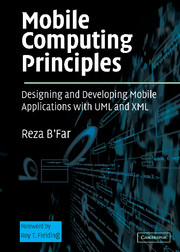Book contents
- Frontmatter
- Contents
- Foreword by Roy T. Fielding
- Acknowledgments
- SECTION 1 INTRODUCTIONS TO THE MAIN TOPICS
- SECTION 2 DEVICE-INDEPENDENT AND MULTICHANNEL USER INTERFACE DEVELOPMENT USING UML
- SECTION 3 ADDITIONAL DIMENSIONS OF MOBILE APPLICATION DEVELOPMENT
- SECTION 4 PUTTING THE PROJECT TOGETHER
- Chapter 15 The Mobile Development Process
- Chapter 16 Architecture, Design, and Technology Selection for Mobile Applications
- Chapter 17 Mobile Application Development Hurdles
- Chapter 18 Testing Mobile Applications
- Chapter 19 A Case Study
- References
- Index
Chapter 19 - A Case Study
from SECTION 4 - PUTTING THE PROJECT TOGETHER
Published online by Cambridge University Press: 03 September 2009
- Frontmatter
- Contents
- Foreword by Roy T. Fielding
- Acknowledgments
- SECTION 1 INTRODUCTIONS TO THE MAIN TOPICS
- SECTION 2 DEVICE-INDEPENDENT AND MULTICHANNEL USER INTERFACE DEVELOPMENT USING UML
- SECTION 3 ADDITIONAL DIMENSIONS OF MOBILE APPLICATION DEVELOPMENT
- SECTION 4 PUTTING THE PROJECT TOGETHER
- Chapter 15 The Mobile Development Process
- Chapter 16 Architecture, Design, and Technology Selection for Mobile Applications
- Chapter 17 Mobile Application Development Hurdles
- Chapter 18 Testing Mobile Applications
- Chapter 19 A Case Study
- References
- Index
Summary
The people in your life are like pillars on your porch. Sometimes they hold you up; sometimes they can lean on you. Sometimes it is just enough to know they are standing by.
INTRODUCTION
Because of the depth of the design discussions in this text, we have had little chance of discussing coherent examples of mobile applications as applied to the various techniques introduced. The goal of this chapter will be to create a large fictitious project, based on a real project, define requirements for it, and then build the application using the techniques introduced. Obviously, we will not be able to use all of the techniques that we have discussed; there are far too many in this text. Nonetheless, we will aim at discussing as many as possible in reasonable detail.
The example we will be introducing will be in the field of automation. Namely, we will be creating an application to help an electrical repair crew with a variety of tasks in the field. We will start by working on the requirements, then create an architecture that satisfies the requirements, follow it up with a detailed level design, and work our way into implementation.
REQUIREMENTS DRIVING THE ARCHITECTURE
First, let us understand the basic needs of the customer for which we are building an application. The reader should know that this example is based on the needs of a real company, the Noor Electrical and Engineering Company, located in Costa Mesa, California.
- Type
- Chapter
- Information
- Mobile Computing PrinciplesDesigning and Developing Mobile Applications with UML and XML, pp. 806 - 818Publisher: Cambridge University PressPrint publication year: 2004



